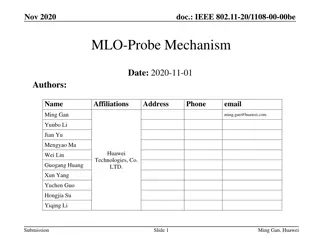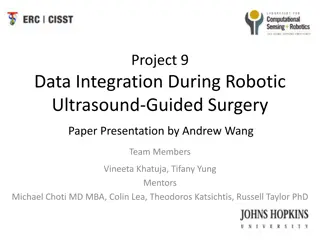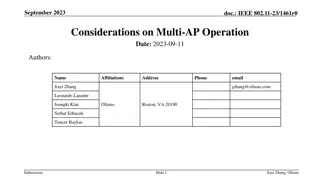Design Considerations for Multi-Link Probe Requests in IEEE 802.11-20
This document discusses the design considerations for multi-link probe requests in the IEEE 802.11-20 standard. It covers passive and active scanning methods, MLD-based versus link-based approaches, and probing for multiple BSSIDs. The focus is on enhancing efficiency and reducing frame bloating in multi-link discovery processes.
Download Presentation

Please find below an Image/Link to download the presentation.
The content on the website is provided AS IS for your information and personal use only. It may not be sold, licensed, or shared on other websites without obtaining consent from the author. Download presentation by click this link. If you encounter any issues during the download, it is possible that the publisher has removed the file from their server.
E N D
Presentation Transcript
doc.: IEEE 802.11-20/1396r0 Multi-Link Probe Request Design Date: 2020-09-14 Authors: Name Affiliations Address Phone email Jason Yuchen Guo Huawei Technologies guoyuchen@huaw ei.com Yunbo Li Guogang Huang Ming Gan Yifan Zhou Yiqing Li Submission Slide 1 Jason Yuchen Guo, et al., Huawei Technologies
doc.: IEEE 802.11-20/1396r0 Introduction We discuss multi-link discovery in this contribution. There are two kinds of discovery methods defined in the 802.11 SPEC Passive scanning: STA receives a Beacon frame which carries the complete information of a BSS Active scanning: STA transmits a probe request frame to solicit the complete information of one or more BSSes In MLO, the Beacon frame may not carry the complete information of all links to avoid Beacon bloating. Motion 115, #SP93: 802.11be shall define mechanism(s) for an AP of an AP MLD to advertise complete or partial information of other links: Partial information to prevent frame bloating. For example, frames exchanged during ML setup are expected to carry complete information while Beacon frame is expected to carry partial information. In that case, a non-AP MLD needs to transmits a probe request frame to solicit complete information of a AP MLD Submission Slide 2 Jason Yuchen Guo, et al., Huawei Technologies
doc.: IEEE 802.11-20/1396r0 MLD based or Link based Motion 119, #SP109 802.11be agrees to define a mechanism for a STA of a non-AP MLD to send a probe request frame to an AP belonging to an AP MLD, which enables to request a probe response from the AP that includes the complete set of capabilities, parameters and operation elements of other APs affiliated to the same MLD as the AP The complete information is defined as all elements that would be provided if the reported AP was transmitting that same frame (exceptions TBD). It is TBD if the AP is mandated or not to respond with the requested information. Note: Such a directed probe request requesting complete MLO information for one or more APs of the MLD is referred to as an ML probe request. Note: A probe response sent in response to an ML probe request containing complete MLO Information for the requested AP(s) is referred to as an ML probe response Question: Is the requested information MLD based or Link based? Opt 1 (MLD based): we only allow the non-AP MLD to probe the complete information of the whole AP MLD Opt 2 (Link based): we allow the non-AP MLD to probe only a subset of the supported links We believe opt 2 is better, because The non-AP MLD may already know the complete information of some links, e.g., By scanning on those links previously The non-AP MLD was associated on some links, and now wants to connect on a new link Submission Slide 3 Jason Yuchen Guo, et al., Huawei Technologies
doc.: IEEE 802.11-20/1396r0 Probe for multiple BSSID Another aspect is the multiple BSSID case Multiple virtual MLDs may be collocated in the same physical device A non-AP MLD should be able to probe all or parts of the collocated/cohosted MLDs Those APs are reported in the RNR without complete information MLD 2 MLD 1 MBSSID1 Link 1 MLD 3 Link 2 MBSSID2 Link 3 MBSSID3 Submission Slide 4 Jason Yuchen Guo, et al., Huawei Technologies
doc.: IEEE 802.11-20/1396r0 Probe for partial information It is agreed that the non-AP MLD can request partial information of the AP MLD Passed SP: A STA of a non-AP MLD can request a peer AP of AP MLD a part of complete information of other APs of the same AP MLD [1] The non-AP MLD may only wants to know specific IEs of other APs of the AP MLD Submission Slide 5 Jason Yuchen Guo, et al., Huawei Technologies
doc.: IEEE 802.11-20/1396r0 Motivation According to the previous discussion, the ML probe request should be able to Probe the complete information of an AP MLD Probe the complete information of specific links of an AP MLD Probe the complete information of multiple AP MLDs Probe partial information of each AP of an AP MLD In this contribution, we propose a unified design to serve the above purpose. Submission Slide 6 Jason Yuchen Guo, et al., Huawei Technologies
doc.: IEEE 802.11-20/1396r0 ML probe request (1) We propose to allow the probe request frame to carry the Multi-Link element to indicate the target of this probing. The MLD MAC address field indicates the MLD MAC address of the target AP MLD One or more per-STA profile subelements indicate the specific links of the target AP MLD that the non-AP MLD wants to probe The per-STA profile subelements are not present if the non-AP MLD intends to probe the complete information of all the supported links of the AP MLD Probe Request Frame Durati on A1 A2 A3 Sequence Control HT Multi-Link Element FCS Frame Control Control Element ID Multi-Link Control Element ID Extension MLD MAC Address Per-STA Profile (x) Per-STA Profile (y) Length Subelement ID Length Data Link Identifier Submission Slide 7 Jason Yuchen Guo, et al., Huawei Technologies
doc.: IEEE 802.11-20/1396r0 ML probe request (2) In the case of multiple BSSID, the probe request frame can carry multiple multi-link element, each of which indicates a target MLD Besides, this structure is flexible enough to allow the non-AP MLD to probe the complete information of different link sets for different MLDs Probe Request Frame Durati on A1 A2 A3 Sequence Control HT Multi-Link Element (1) Multi-Link Element (2) FCS Frame Control Control MLD MAC Address Per-STA Profile (1x) Per-STA Profile (1y) MLD MAC Address Per-STA Profile (2y) Per-STA Profile (2z) Subelement ID Length Data Subelement ID Length Data Link Identifier Link Identifier Submission Slide 8 Jason Yuchen Guo, et al., Huawei Technologies
doc.: IEEE 802.11-20/1396r0 ML probe request (3) The non-AP MLD may need to carry a multi-link element in the probe request frame to indicate its own MLD information Need a bit in the Multi-Link field to differentiate the type of the multi-link element, e.g., 0 means this multi-link element carries the MLD information of the non-AP MLD 1 means this multi-link element indicates the target AP MLD for the probe request In this case, the per-STA profile Subelement only carries the Link Identifier Subelement Probe Request Frame Durati on A1 A2 A3 Sequence Control HT Multi-Link Element FCS Frame Control Control Element ID Multi-Link Control Element ID Extension MLD MAC Address Per-STA Profile (x) Per-STA Profile (y) Length Subelement ID Length Data Target MLD TBD TBD Link Identifier Submission Slide 9 Jason Yuchen Guo, et al., Huawei Technologies
doc.: IEEE 802.11-20/1396r0 ML probe request (4) In order to request partial information (specific IEs) of an AP MLD, we propose to reuse the non-inheritance element carried in the per-STA profile Subelement to indicate the Information Elements that the non-AP MLD wants to probe Note that the target MLD subfield is set to 1 in this case Probe Request Frame Durati on A1 A2 A3 Sequence Control HT Multi-Link Element FCS Frame Control Control Element ID Multi-Link Control Element ID Extension MLD MAC Address Per-STA Profile (x) Per-STA Profile (y) Length Subelement ID Length Data Link Identifier Non-inheritance element Submission Slide 10 Jason Yuchen Guo, et al., Huawei Technologies
doc.: IEEE 802.11-20/1396r0 Conclusion We propose a unified design of multi-link probe request, which carries multi-link element to indicate: The target MLD Multiple MLDs The target links of one or more MLDs The target information elements of one or more links of one or more MLDs Submission Slide 11 Jason Yuchen Guo, et al., Huawei Technologies
doc.: IEEE 802.11-20/1396r0 Straw Poll 1 Do you agree that a non-AP MLD can carry a multi-link element in the probe request frame to probe complete information of an AP MLD? The MLD MAC Address field indicates the MLD address of the target AP MLD The per-STA profile subelements indicate the specific links of the target AP MLD that the non-AP MLD wants to probe Submission Slide 12 Jason Yuchen Guo, et al., Huawei Technologies
doc.: IEEE 802.11-20/1396r0 Straw Poll 2 Do you agree that the multi-link element can carry a subfield in the multi-link control field to indicate whether the multi-link element carries the MLD information of the non-AP MLD, or it carries the information of the target AP MLD for the probe request? Submission Slide 13 Jason Yuchen Guo, et al., Huawei Technologies
doc.: IEEE 802.11-20/1396r0 Straw Poll 3 Do you agree that the probe request frame can carry multiple multi- link elements to probe the information of multiple MLDs? Submission Slide 14 Jason Yuchen Guo, et al., Huawei Technologies
doc.: IEEE 802.11-20/1396r0 Straw Poll 4 Do you agree that the per-STA profile Subelement of the multi-link element in the probe request frame can carry non-inheritance element to indicate the list of information elements that the non-AP MLD requests to probe? Submission Slide 15 Jason Yuchen Guo, et al., Huawei Technologies
doc.: IEEE 802.11-20/1396r0 References [1] 11-20-0411-04-00be-mlo-information-exchange-for-link-switching Submission Slide 16 Jason Yuchen Guo, et al., Huawei Technologies





























